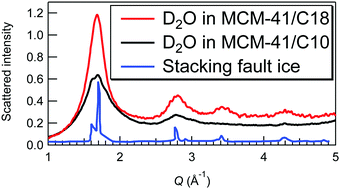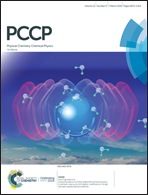Ice crystallization observed in highly supercooled confined water†
Abstract
We investigate the state of water confined in the cylindrical pores of MCM-41 type mesoporous silica, with pore diameters of 2.8 nm and 4.5 nm, over the temperature range 160–290 K by combining small angle neutron scattering and wide angle diffraction. This allows us to observe simultaneously the intermolecular correlations in the local water structure (which shows up in a main water peak around Q = 1.7 Å−1), the two-dimensional hexagonal arrangement of water cylinders in the silica matrix (which gives rise to a pronounced Bragg peak around Q = 0.2 Å−1), and the so-called Porod scattering at smaller Q, which arises from larger scale interfacial scattering within the material. In the literature, the temperature evolution of the intensity of the Bragg peak has been interpreted as the signature of a density minimum in confined water at approximately 210 K. Here we show that, under the conditions of our experiment, a fraction of freezable water coexists with a layer of non-freezable water within the pore volume. The overall temperature dependence of our data in the different Q regions, as well as the comparison of the data for the two pore sizes, leads us to conclude that the observed variation in the intensity of the Bragg diffraction peak is actually caused by a liquid to ice transition in the freezable fraction of confined water.



 Please wait while we load your content...
Please wait while we load your content...